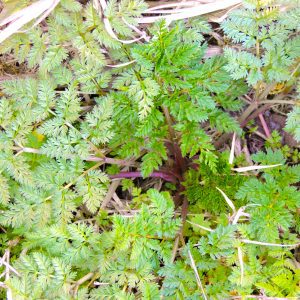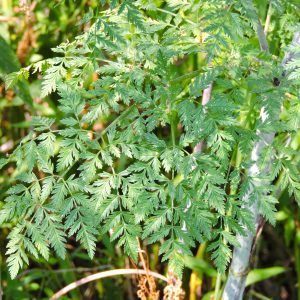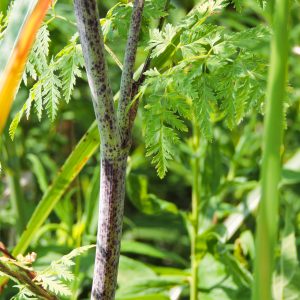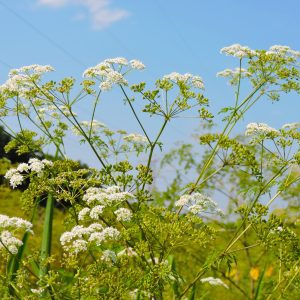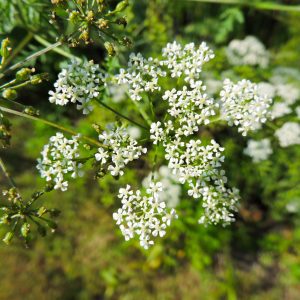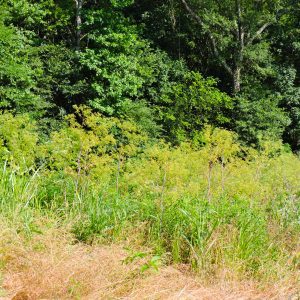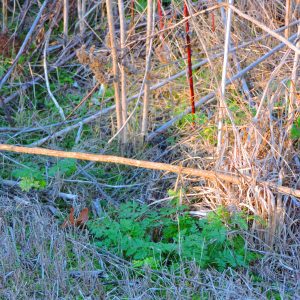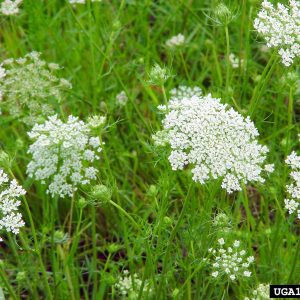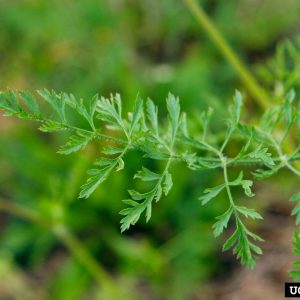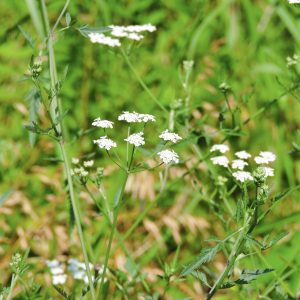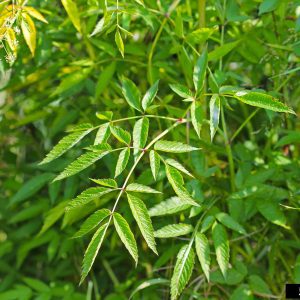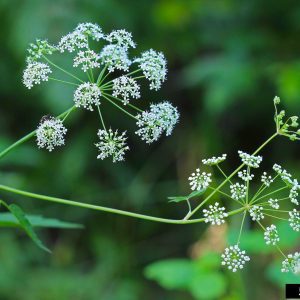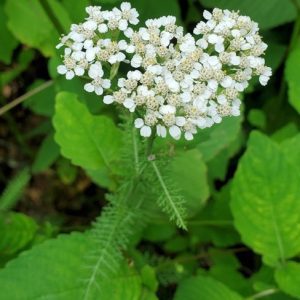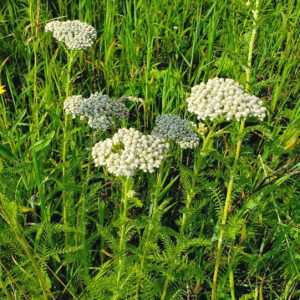Forestry & Wildlife

As a member of the carrot family (Apiaceae), poison hemlock is in the same family with many familiar edible plants and herbs, including carrots, celery, parsnip, parsley, cilantro, and dill. However, this plant is definitely not edible and is one to keep away from the dinner table.
Poison hemlock (Conium maculatum) (figure 1) is a poisonous herbaceous plant native to Europe. Famously, this is the “poison hemlock” of antiquity that killed the Greek philosopher Socrates. Introduced to the United States in the 1800s as an ornamental (a plant purposefully grown for its beauty or other valuable characteristic), poison hemlock has since spread across most of the continental United States, particularly in western and northern states and adjacent regions of Canada. While it is less common in southeastern states, it is becoming more frequent in the Alabama landscape.
Threats
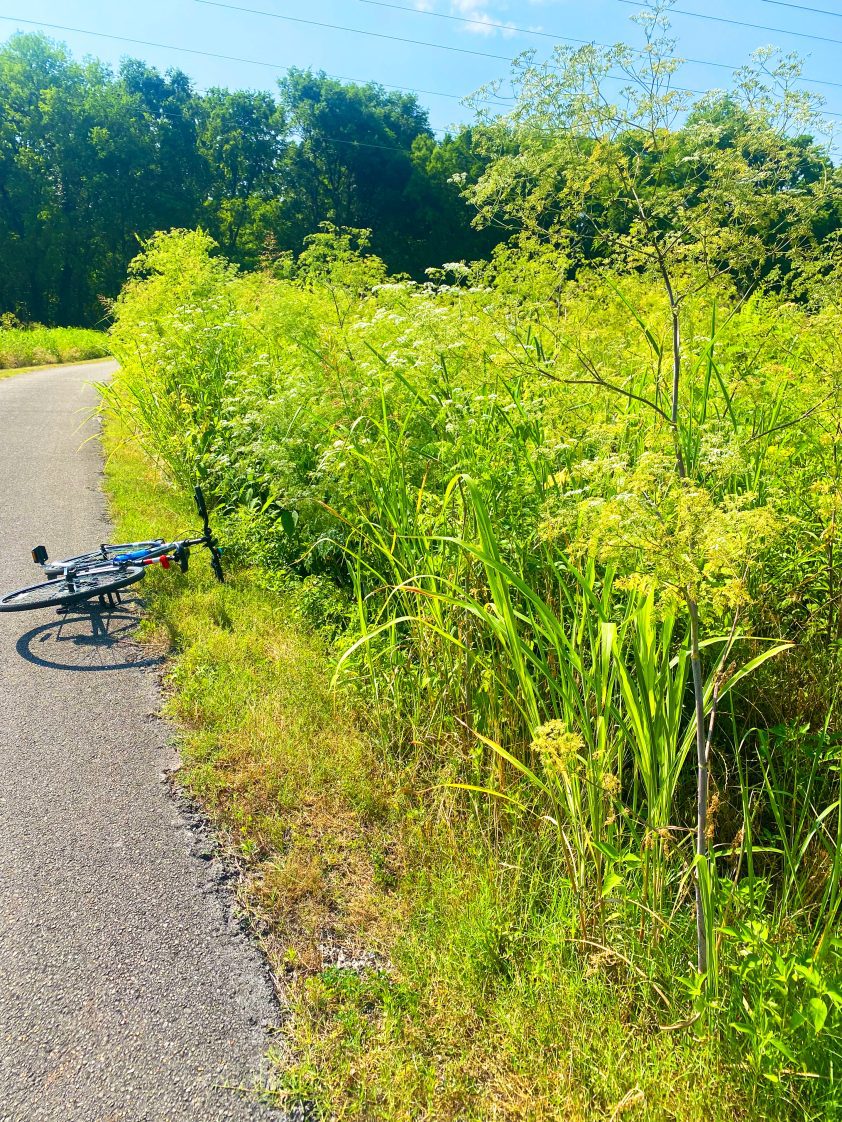
Figure 1. Poison hemlock growing next to a popular paved trail in Colbert County.
All parts of poison hemlock (roots, leaves, flowers, seeds, and stems) are poisonous to people and livestock. These plants contain several alkaloid chemicals that are highly toxic. The most severe reactions related to ingestion involve the slowing down or depression of the central nervous system, leading to muscle paralysis of the heart and lungs followed by suffocation and death. Do NOT eat any part of this plant.
Skin contact with the plant or plant sap can cause dermatitis or skin irritation. Like poison ivy, the degree of reaction can vary greatly depending on the amount of contact with the plant and among individuals. More severe reactions may occur if sap enters cuts in the skin or gets into the eyes, nose, or mouth. Severe symptoms of dermatitis may warrant a trip to a medical clinic.
Most livestock typically avoid eating these plants as the leaves are unpalatable and can produce an unpleasant odor. However, swine and possibly sheep may readily consume young leaves until they become less palatable as the plant matures. Although it may not be palatable, if other feed is unavailable, these plants may be ingested. One primary risk occurs during the spring when leaves of poison hemlock are small and intermixed with other grasses and forage, potentially leading to the plant being inadvertently consumed. Risk is also associated with harvesting forages where this plant is intermixed.
In cattle, as little as 300 grams or about 0.5 percent of an individual’s body weight can provide a lethal dose of toxin. In sheep, 100 to 500 grams may lead to lethal poisoning. The process of poisoning is quick, with signs of distress typically appearing within an hour of ingestion and death from respiratory paralysis occurring within 2 to 3 hours. Birth deformities are known to appear in offspring that are born from livestock that have ingested nonlethal amounts of poison hemlock during pregnancy.
Habitat and Distribution
Populations of poison hemlock are primarily moving slowly from north to south through the state. Currently, it is reported in at least eleven counties in north Alabama (Colbert, DeKalb, Etowah, Jackson, Lawrence, Limestone, Madison, St. Clair, Shelby, Talladega, and Tuscaloosa) and Mobile County in south Alabama. It grows best in shady areas with moist soil but can tolerate a range of conditions including full sun. Infestations often occur in disturbed areas, such as power line rights-of-way or utility easements, roadsides, ditches, and abandoned lands. It may also be found in pastures, field and forest margins, and along streams and low-lying areas.
Identification
Poison hemlock is a biennial, meaning it has a 2-year life cycle. In the first year, plants form a “rosette” or cluster of leaves spreading outward from a short stem, not gaining much height (figure 2a). In the second year, with the help of a well-established taproot, the plants bolt, reaching heights of 3 to 10 feet and producing many flower heads. After seeds have set, the plants die but remain standing, and seeds are dispersed to begin the process again.
The leaves of poison hemlock are pinnately compound. This means that each leaf is made up of many leaflets. The leaflets are smooth (not hairy) and are finely divided and taper to a point (figures 2a and 2b). The outline of the entire leaf forms a broad triangle or oval shape (figure 2b). Stems are hollow (except at the nodes), glabrous, and slightly ribbed with distinctive purple-colored splotches or lines (figure 3). Plants bloom in the early summer, producing many umbrella-shaped flower heads (figure 4) with distinct clusters of small, five-petaled white flowers (figure 5). Plants often remain standing after flowering and fruiting (figure 6) and can remain standing through the winter and early spring as the rosette stage of poison hemlock grows underneath (figure 7).
- Figure 2a. Poison hemlock rosette stage.
- Figure 2b. Poison hemlock foliage.
- Figure 3. Poison hemlock stem with purple splotches.
- Figure 4. Poison hemlock flower heads.
- Figure 5. Clusters of poison hemlock flowers.
- Figure 6. Poison hemlock (yellowish-green plants) standing after flowering.
- Figure 7. Poison hemlock rosettes growing beneath many still standing stems of the same species that bolted the previous year.
Look-Alikes
At first glance, several other species in the Apiaceae family may look like poison hemlock, with similar leaves or flowers but with several differences that help distinguish them from one another. Several unrelated species have similar-looking flowers but differ in key characteristics.
Queen Anne’s lace or wild carrot (Daucus carota) (figures 8 and 9) is also an herbaceous biennial in the Apiaceae family. Like poison hemlock, it is an introduced plant commonly occurring in disturbed open areas. However, there are several distinct differences: Queen Anne’s lace only reaches a height of 2 to 3 feet, and the flower heads typically have a flatter, fuller shape with more densely packed flowers. The leaves and stems are hairy, and the stems lack purple splotches.
Hedge parsley (Torilis arvensis) (figure 10) is another non-native herbaceous plant in the Apiaceae family, also commonly found in disturbed areas. While the leaves and flowers look somewhat like those of poison hemlock, these plants are generally much shorter (ranging from 1 to 3 feet tall), have fewer and smaller flower clusters, have slender stems covered with fine white hairs, and lack purple splotches.
- Figure 8. Queen Anne’s lace flower heads. (Photo credit: Chris Evans, University of Illinois, Bugwood.org)
- Figure 9. Queen Anne’s lace foliage and stems. (Photo credit: Chris Evans, University of Illinois, Bugwood.org)
- Figure 10. Hedge parsley.
Water hemlock or spotted water hemlock (Cicuta maculata) (figures 11 and 12) and southern water hemlock (Cicuta mexicana) are native species in the Apiaceae family. Like poison hemlock, all parts of these plants are highly toxic and should be avoided. Plants are 3 to 8 feet tall and have similar white umbrella-shaped flowers. Stems may be solid green or purple or have purple streaking or mottling similar to poison hemlock. The leaves are notably different, with larger toothed leaflets. As the name suggests, water hemlock typically grows in wet areas such as margins of ponds, wet ditches, wet meadows, and other swampy areas. Water hemlock and poison hemlock should not be confused with the native coniferous tree commonly called hemlock or eastern hemlock (Tsuga canadensis), which is not poisonous.
Wild or common yarrow (Achillea millefolium) (figures 13 and 14) is a perennial member of the sunflower family (Asteraceae) and is found throughout Alabama. It may resemble poison hemlock, but there are several apparent differences. Reaching only 1 to 3 feet tall, it has hairy and finely divided leaves that are generally oval to elongated rather than triangular in outline. While the flower heads may look similar at first glance, they are flatter and the individual flowers are larger and structurally different than those on poison hemlock and may range in color from white to yellow to pink. Another difference is that the stems lack purple splotches.
- Figure 11. Water hemlock foliage. (Photo credit: Rob Routledge, Sault College, Bugwood.org)
- Figure 12. Water hemlock flower head. (Photo credit: Rob Routledge, Sault College, Bugwood.org)
- Figure 13. Wild yarrow flowers.
- Figure 14. Wild yarrow in field.
Control
Tillage or cultivation of newly germinated plants can effectively prevent seedlings from establishing. Small plants can be pulled (wearing gloves, long sleeves, long pants, and protective eyewear), with all plant material bagged and placed in the trash as dead plants remain toxic. Mowing is effective only if repeated throughout the growing season, as plants can regrow and reflower after mowing. Avoid contact with plant debris and fumes when mowing. Wearing protective eyewear and a dust mask is recommended.
Several broadleaf herbicides labeled for use in turf and ornamental, rights-of-way, and forage crop settings are effective on poison hemlock. Treatment is most effective if applied to first-year rosettes but can also be applied to second-year stalks before flowering. Because poison hemlock produces a lot of seeds that can remain viable in the soil for years, several years of monitoring and treatment of emerging plants may be required for complete control.
Glyphosate, the active ingredient in Roundup and many other commonly found products, can offer good control when applied as a foliar spray in the spring, but is nonselective and can injure or kill nearby desirable plants. Herbicides such as 2,4-D, dicamba, and triclopyr are generally safe on desirable grass species and are options to consider when poison hemlock is growing in pastures. Escort XP and Method 240SL herbicides are also labeled for poison hemlock control.
When using herbicides, always read and follow the herbicide label, paying attention to site and rate restrictions and safety recommendations for applicators.
References
- Burrows, G. E., & Tyrl, R. J. (2013). Toxic plants of North America. Wiley-Blackwell.
- Poison Hemlock. USDA Agricultural Research Service, Poisonous Plant Research: Logan UT. (2018, June 26).
- USDA Agricultural Research Service . (2018, June 26). Poison Hemlock. Poisonous Plant Research: Logan, UT.
- Cornell University. (n.d.). Poison Hemlock. Cornell Weed Identification.
- Soto, P. (n.d.). Can poison hemlock be deadly?. Poison Control.
 Kerry Steedley, Regional Extension Agent; Nancy Loewenstein, Extension Specialist, Forestry, Wildlife, and Natural Resources; and David Russell, Assistant Extension Professor, Crop, Soil, and Environmental Sciences, all with Auburn University
Kerry Steedley, Regional Extension Agent; Nancy Loewenstein, Extension Specialist, Forestry, Wildlife, and Natural Resources; and David Russell, Assistant Extension Professor, Crop, Soil, and Environmental Sciences, all with Auburn University
New May 2024, Poison Hemlock in Alabama, FOR-2150


